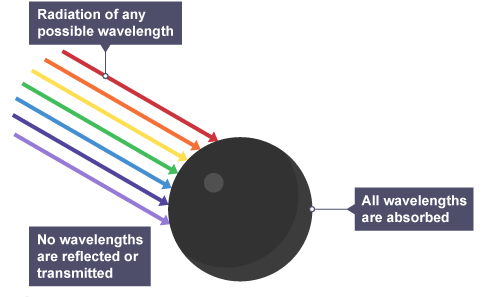What is Black Body Radiation? | Physics for Grade 10 PDF Download
| Table of contents |

|
| Emission & Absorption of Infrared Radiation |

|
| Required Practical |

|
| The Earth's Temperature - Higher |

|
| Factors Affecting the Earth’s Temperature |

|
| The Greenhouse Effect |

|
Emission & Absorption of Infrared Radiation
All bodies (objects) emit and absorb infrared radiation. They do this whatever their temperature. The hotter the body:- the more infrared radiation it gives out in a given time
- the greater the proportion of emitted radiation is visible light
Black bodies: There are no known objects that are perfect at absorbing or emitting all the radiation, of every possible frequency, that may be directed at it. Some objects do, however, come close to this and these are referred to as "black bodies".
A perfect black body is a theoretical object. It would have these properties:
- it would absorb all the radiation that falls on it
- it would not reflect or transmit any radiation
An object that is good at absorbing radiation is also a good emitter, so a perfect black body would be the best possible emitter of radiation.
 Features of a perfect black body
Features of a perfect black body
Stars are considered to be black bodies because they are very good emitters of most wavelengths in the electromagnetic spectrum. This suggests that stars also absorb most wavelengths. Whilst there are a few wavelengths that stars do not absorb or emit, this figure is very low, so they can be treated as black bodies. Planets and black holes are also treated as nearly perfect black bodies.
Poor absorbers and emitters
White and shiny silvery surfaces are the worst absorbers, as they reflect all visible light wavelengths. Poor absorbers are also poor emitters, and do not emit radiation as quickly as darker colours. Radiators in homes are usually painted white so that the infrared radiation is emitted gradually.Required Practical
Investigate how the amount of infrared radiation absorbed or radiated by a surface depends on the nature of that surfaceThere are different ways to investigate the amount of infrared radiation absorbed or radiated by a surface. It is important to:
- use appropriate apparatus to measure and record temperature accurately
- make observations regarding the effects of electromagnetic waves on different substances
The method described here uses a Leslie cube. This is a metal cube with four different types of surface. It is filled with hot water to increase its temperature.
Aim of the experiment

To investigate how the amount of infrared radiation absorbed or radiated by a surface depends on the nature of that surface.
Method
- Place a Leslie cube on a heat-resistant mat. Fill it, almost to the top, with boiling water and replace the lid.
- Leave for one minute. This is to enable the surfaces to heat up to the temperature of the water.
- Use the infrared detector to measure the intensity of infrared radiation emitted from each surface, or the temperature of the surface. Make sure that the detector is the same distance from each surface for each reading.
Results
Record results in a suitable table. The Table below shows some example results:
Analysis
- Plot a bar chart to show the results. Make sure each bar is the same width and labelled clearly to show which surface it represents.

- Use your results to order the different surfaces from the best emitter to the worst emitter of infrared radiation.
Evaluation
Explain why the detector must be placed the same distance from each surface before taking a reading.
Hazards and control measures
The Earth's Temperature - Higher
The temperature of a body is linked to the balance between the amount of radiation absorbed and emitted.
Factors Affecting the Earth’s Temperature
The temperature of the Earth depends on many factors including the concentration of greenhouse gases such as water vapour, methane and carbon dioxide.The Earth’s temperature also depends on the rates at which light radiation and infrared radiation are:
- absorbed by the Earth’s surface and atmosphere
- emitted by the Earth’s surface and atmosphere
When visible light and high frequency infrared radiation are absorbed by the surface of the Earth, the planet’s internal energy increases and the surface gets hotter. Some of this energy is transferred to the atmosphere by conduction and convection.
The Earth also radiates lower frequency infrared radiation. Some of this infrared radiation is transmitted through the atmosphere back out into space, and some is absorbed by greenhouse gases in the atmosphere. The greenhouse gases emit infrared radiation in all directions - some out into space and some back towards Earth, which is then reabsorbed.
The Greenhouse Effect
- The ‘greenhouse effect’ caused by naturally occurring greenhouse gases, such as water vapour, stabilises the surface temperature of Earth. This allows the planet to support life.
- However, human activities such as deforestation and the burning of fossil fuels are releasing additional carbon dioxide. This causes more infrared radiation to be ‘trapped’ and reabsorbed by the Earth’s surface. This enhanced greenhouse effect is causing global temperatures to increase, leading to climate change.
|
124 videos|149 docs|37 tests
|

|
Explore Courses for Grade 10 exam
|

|
















